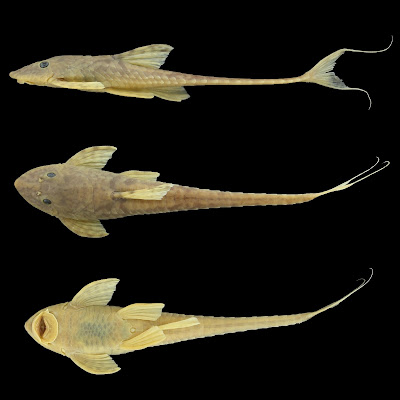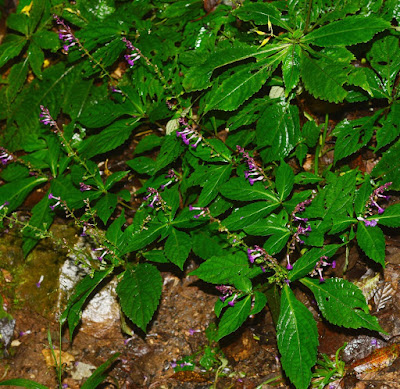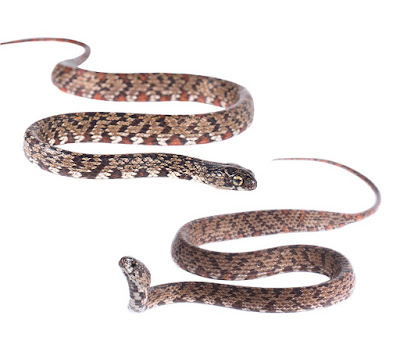[Most Recent Entries] [Calendar View]
Friday, December 6th, 2019
| Time | Event | ||||
| 1:48a | [Herpetology • 2018] Scinax tsachila • Advertisement Calls and DNA Sequences Reveal A New Species of Scinax (Anura: Hylidae) on the Pacific Lowlands of Ecuador
Abstract Scinax is a speciose genus of Neotropical hylid frogs. We describe a new species from western Ecuador (elevations between 0 and 1207 m) using morphology, vocalizations, and DNA sequences. We also present a new phylogeny for Scinax based on mitochondrial DNA genes 12S rRNA, Cytochrome Oxidase sub-unit I, Cytochrome B, 16S rRNA, NADH dehydrogenase subunit 1, and adjacent tRNAs. The new species, Scinax tsachila sp. nov. was previously confused with S. quinquefasciatus, a morphologically similar sympatric species. They differ by having markedly different advisement calls, distinct skin texture in the dorsum, and different bone coloration. The new species is sister to S. elaeochroa, a species that differs in advertisement call and color pattern. We provide an updated species account for Scinax quinquefasciatus and a redescription of its holotype. Scinax tsachila sp. nov. Diagnosis: (1) Average SVL in males 31.6 mm (range 27.2–34.2), in females 34.7 mm (range 33.2–36.4), Table 3; (2) snout acutely rounded in dorsal view and in profile; (3) ulnar and tarsal tubercles absent; (4) enlarged heel tubercle absent; (5) tubercles absent on lower jaw; (6) skin on dorsum smooth to shagreen without scattered tubercles; (7) diameter of tympanum 15.0% of head length; (8) dorsum cream to reddish brown with or without longitudinal brown stripes; (9) flanks lacking patterns; (10) posterior surfaces of thighs without markings; (11) iris brown with orange flecks to orange-yellow with brown reticulations.
Distribution and ecology: Scinax tsachila occurs in the Pacific Basin of Ecuador. Specimens with elevation data range from 0 to 1207 m above sea level (near Mindo, Provincia Pichincha; Fig 6). The available evidence suggests the occurrence of S. tsachila in Colombia. Records of “S. elaeochroa” from, Nariño Department, Colombia, [62,63] likely represent S. tsachila as some of they are only 70 km from S. tsachila populations in Ecuador. .... Etymology: The specific name is a noun in apposition. The epithet refers to the Tsáchila people who inhabit the area within the range of Scinax tsachila in Ecuador. Men in this ethnic group mold their hair into a helmet-like shape that is dyed red with the juice of the achiote bush (Bixaceae: Bixa orellana). The Spaniards called them “Colorados” (colored red). Hence the former name of the major population center in the area, Santo Domingo de los Colorados. Remarks: A potential senior synonym for S. tsachila is Hyla dulcensis [65]. Its type locality is “Golfito, Puntarenas Province, Costa Rica”. Hyla dulcensis was considered a junior synonym of S. elaeochroa by Duellman [66]. Examination of the holotype of H. dulcensis (KU 32168) confirms that it is not conspecific with S. tsachila. The holotype has the characteristic dark interorbital triangular mark present in most S. elaeochroa. This is supported by the phylogeny which shows that samples of S. elaeochroa from Costa Rica, which are geographically close to the type locality of H. dulcensis, are genetically distinct from those of S. tsachila. Santiago R. Ron , William E. Duellman, Marcel A. Caminer and Diana Pazmiño. 2018. Advertisement Calls and DNA Sequences Reveal A New Species of Scinax (Anura: Hylidae) on the Pacific Lowlands of Ecuador. PLoS ONE. 13(9): e0203169. DOI: 10.1371/journal.pone.0203169 | ||||
| 2:01a | [Ichthyology • 2019] A Taxonomic Revision of Sturisomatichthys Isbrücker and Nijssen, 1979 (Loricariidae: Loricariinae), with Descriptions of Three New Species
Abstract A taxonomic revision of Sturisomatichthys is presented. A total of 383 specimens including both type and non-type specimens of all valid species were examined. Sturisomatichthys was found to encompass ten valid species: Sturisomatichthys aureus, S. caquetae, S. citurensis, S. dariensis, S. festivus, S. frenatus, S. kneri, S. leightoni, S. panamensis, and S. tamanae. In addition, three new species are described: Sturisomatichthys reinae, new species, from the Baudó River, in northwestern Colombia, belonging to the Caribbean slope of the continent; Sturisomatichthys guaitipan, new species, from the upper and middle Magdalena River basin, Colombia; and Sturisomatichthys varii, new species, from the San Juan River basin in western Colombia, on the Pacific slope. Sturisomatichthys caquetae, from the Morelia River, upper Amazon, is transferred back from Sturisoma, and S. leightoni was found to be distributed, besides the Magdalena-Cauca basin, in the Orinoco basin; thus, Sturisomatichthys is shown to be distributed in both trans- and cis-Andean drainages. A neotype is designated for S. aureus from the lower Magdalena basin. New records of localities in the northwestern region of South America, as well as the redescription and taxonomic comments on all valid species, are provided. Maps with the species distributions and a key for identification of the species are provided. Sturisomatichthys Isbrücker and Nijssen, 1979 Sturisomatichthys Isbrucker and Nijssen, in Isbrücker , 1979:91 (type species: Oxyloricaria leightoni Regan, 1912, by original designation; gender: masculine). Included taxa.— Sturisomatichthys aureus; S. caquetae; S. citurensis; S. dariensis; S. festivus; S. frenatus; S. kneri; S. leightoni; S. panamensis; S. tamanae; Sturisomatichthys guaitipan, new species; Sturisomatichthys reinae, new species; Sturisomatichthys varii, new species. Placement in Loricariinae.—Sturisomatichthys belongs to the Farlowellina, along with Aposturisoma; Farlowella (type genus); Lamontichthys; Pterosturisoma; and Sturisoma. Sturisomatichthys aureus (Steindachner, 1900) Sturisomatichthys caquetae (Fowler, 1945) Sturisomatichthys citurensis (Meek and Hildebrand, 1913) Sturisomatichthys dariensis (Meek and Hildebrand, 1913) Sturisomatichthys festivus (Myers, 1942) Sturisomatichthys frenatus (Boulenger, 1902) Sturisomatichthys kneri (Ghazzi, 2005) Sturisomatichthys leightoni (Regan, 1912) Sturisomatichthys panamensis (Eigenmann and Eigenmann, 1889) Sturisomatichthys tamanae (Regan, 1912) Sturisomatichthys reinae, new species Etymology.—The specific name honors Mrs. Ruth Gisela Reina, late curator of fishes at STRI, for her contributions to the knowledge of fishes and invaluable help and assistance for several ichthyologists around the world during her time at the STRI.
Sturisomatichthys guaitipan, new species Etymology.—The specific epithet guaitipan honors Gaitana, an indigenous heroine from the 16th century, cacique of the Timaná tribe, who occupied the Colombian Andes in the upper Magdalena valley in the Meta department. Gaitana, or Guaitipan as she was also known, fought against the Spanish invasion that occurred in South America between 1539 and 1540, ending in her defeat due to treason by the cacique Matambo, who warned the Spanish army of the rebellion led by Gaitana. Finally in 1626, joining forces with the Pijaos, Panaes, and Pamaos, they obtained victory by expelling the Spanish from their region. Sturisomatichthys varii, new species Etymology.—The specific name honors Richard P. Vari for his important and numerous contributions to the knowledge of Neotropical fishes, and for his interest in helping young ichthyologists pursue careers in science to continue to explore the diversity of such Neotropical fishes. Richard left an important legacy which, with no doubt, will help present and future ichthyologists in their research. The conclusion of this study would not have being possible without the selfless and extensive help received from Richard. Alejandro Londoño-Burbano and Roberto E. Reis. 2019. A Taxonomic Revision of Sturisomatichthys Isbrücker and Nijssen, 1979 (Loricariidae: Loricariinae), with Descriptions of Three New Species. Copeia. 107(4); 764-806. DOI: 10.1643/CI-19-226 | ||||
| 2:02a | [Botany • 2019] Molecular and Morphological Evidence for, Siphocranion flavidum, A New Species of Siphocranion (Lamiaceae) from the Sino-Vietnamese Border
Abstract Siphocranion is an oligotypic genus of Lamiaceae, with two species mainly distributed in subtropical China and one of them found also in northeastern India, Myanmar, and Vietnam. Based on field investigation, morphological comparison, and molecular phylogenetic analyses, a new species of Siphocranion from the Sino-Vietnamese border is described as S. flavidum. Bayesian and maximum likelihood analyses on two nuclear ribosomal DNA regions and six plastid DNA regions reveal that S. flavidum is a distinct species in the genus and may be sister to the clade formed by the remaining two species of Siphocranion. Morphologically, the new species differs from S. macranthum and S. nudipes in its strigose stem with dark purple spots, thick papery lamina, significantly larger calyx, pale yellow corolla with tube slightly saccate at anterior side of base. Keywords: Eudicots, new species, Ocimeae, Sino-Vietnamese border, Siphocranion, Siphocranioninae Siphocranion nudipes (Hemsl.) Kudô Ya-Ping Chen, Xin-Xin Zhu, Fei Zhao, Hui-Zhe Feng, Alan Paton and Chun-Lei Xiang. 2019. Molecular and Morphological Evidence for A New Species of Siphocranion (Lamiaceae) from the Sino-Vietnamese Border. Phytotaxa. 425(1); 1–18. DOI: 10.11646/phytotaxa.425.1.1 | ||||
| 2:13a | [Herpetology • 2019] Sibon ayerbeorum • A New Species of Sibon Fitzinger, 1826 (Squamata: Colubridae) from Southwestern Colombia
Abstract A new species of the genus Sibon is described based on four specimens from Parque Nacional Natural Munchique, department of Cauca, Colombia. The new species differs from all members of the S. annulatus and S. nebulatus groups because it has an ocellate pattern, which places it into the S. argus species group. It differs from S. argus by having non-protuberant eyes, fewer ventrals, subcaudals, and total segmental counts; and it differs from S. longifrenis by having fewer segmental counts in males and females, only six supralabials and postmentals absent. Additionally, it differs from both species due to its smaller body size. Keywords: Reptilia, Sibon ayerbeorum sp. nov., snail-eating snakes, Dipsadini, Parque Nacional Natural Munchique, Cauca, endemic species
Sibon ayerbeorum sp. nov. Sibon cf. lamari: Ayerbe et al. (2007). Proposed common name: Ayerbes’ Snail-eater Proposed common Spainish name: Caracolera de los Ayerbe Luis Enrique Vera-Pérez. 2019. A New Species of Sibon Fitzinger, 1826 (Squamata: Colubridae) from Southwestern Colombia. Zootaxa. 4701(5); 443–453. DOI: 10.11646/zootaxa.4701.5.4 Resumen: Se describe una nueva especie del género Sibon a partir de cuatro especímenes del Parque Nacional Natural Munchique, departamento del Cauca, Colombia. La nueva especie difiere de todos los miembros de los grupos S. annulatus y S. nebulatus por tener un patrón ocelado, que la coloca dentro del grupo de especies S. argus. Se distingue de S. argus por tener ojos no protuberantes, menos escamas ventrales, subcaudales y conteos de segmentos totales; y difiere de S. longifrenis por tener menos conteos de segmentos en machos y hembras, solo seis supralabiales y ausencia de postmental. Además, difiere de ambas especies por su tamaño corporal menor. |
| << Previous Day |
2019/12/06 [Calendar] |
Next Day >> |






